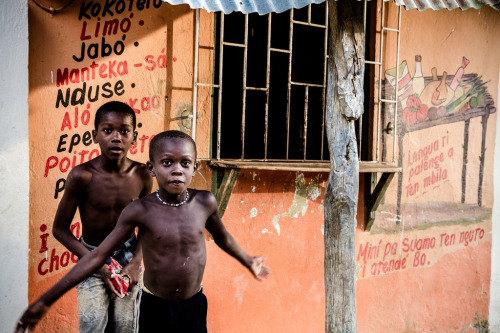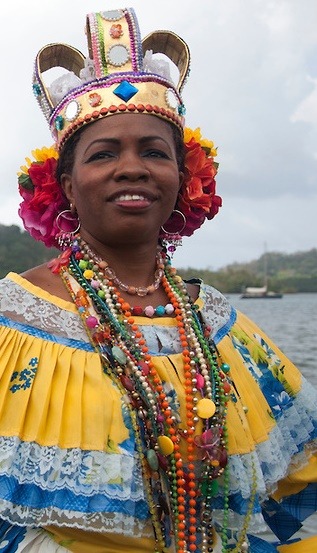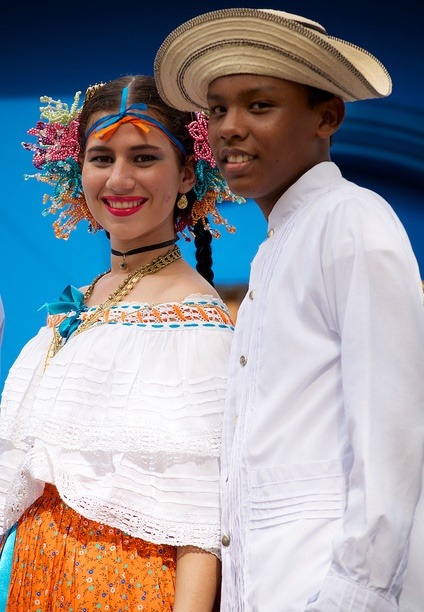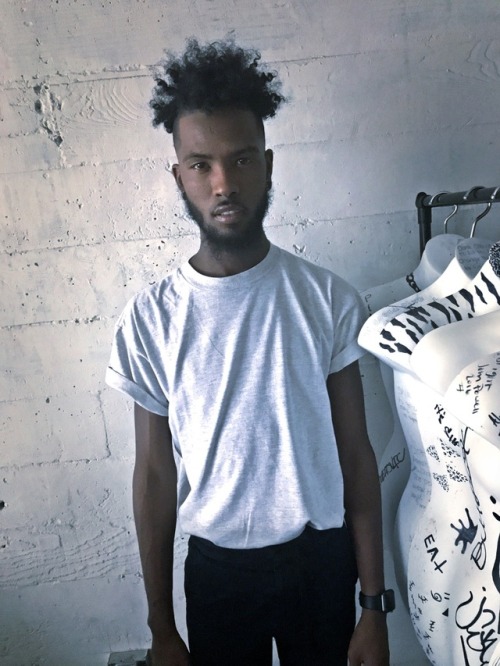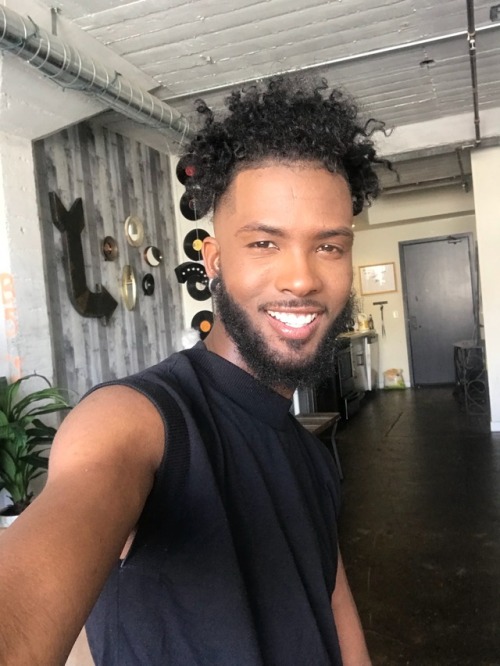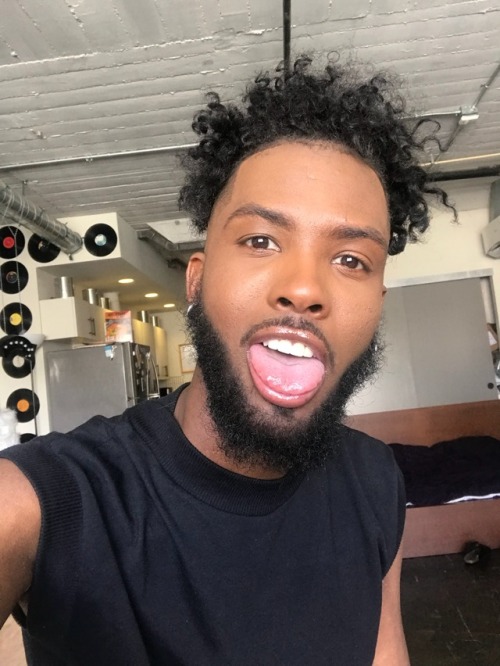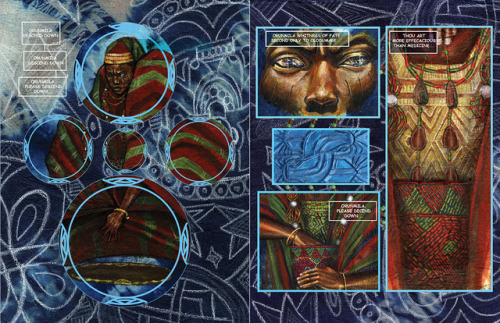#afro latino


Living my life in NYC as an essential worker and by the grace of God healthy and alive!
Colombian children play in front of a grocery store advertising products in Palenquero
Palenquero is Latin America’s only surviving African-Spanish creole, that is spoken natively as a first language. Its speakers are based in the maroon town of San Basilio de Palenque on the Caribbean coast of Colombia. Palenque is considered to be the first self-liberated settlement of Afro-descendants in South America; founded in the 17th century by Africans seeking refuge from slavery. Although Palenquero employs the lexicon of various African languages, most of the Africans brought to the Caribbean coast of Colombia were from areas of modern-day Congo and Angola, and for this reason over 90% of the creole’s African-based lexicon has it’s origins in the Bantu linguistic family. The language is believed to be the most African-infused creole in the Americas, given it’s long history and isolation from European languages, and for this reason there’s little mutual intelligibility between Spanish and Palenquero speakers.
In the last few decades there has been a language shift from Palenquero to Spanish, and for this reason the number of native speakers has dropped significantly. It is estimated that only about half of the town speaks Palenquero fluently, that 88.7 percent of high school students use Spanish as their first language, and that only 15 percent of those students have frequent access to the Palenquero language outside school. One of the reasons for this shift, is that many Palenqueros traveled outside of their town to work in nearby banana plantations, where they were discriminated and ostracized for speaking their language by Spanish speakers; which until that time they had little to no interaction with. Another reason for the language shift, is due to accessibility with the rest of Colombia through the media.
However, with accessibility to the rest of Colombia via television and radio, also came accessibility to various cultures in Africa. Cultural interactions between Palenque and Africa have strengthened the black pride and consciousness of Palenqueros, which has also given the community an urgency to preserve the language. Many young musicians perform champeta songs in the Palenquero language; champeta is a popular genre of music which mixes Palenquero folklore and West/Central African genres such as soukous and highlife. Palenquero has also been made a mandatory language in schools, and linguists have also created the first dictionary of the language with the help of the towns elders. Recent studies have found a trend in younger generations, welcoming the concept of bilingualism.
Post link
The Pollera and Somberero Pintado: Symbols of Panamanian Culture
La Pollera
Refers to the traditional costume of Panama worn by women consisting of a skirt and a blouse. Its origins are that of Spanish clothing worn by peasant women in the seventeenth century. The most iconic pollera is that of the pollera de gala; its development began when upper-class Spanish women started settling in the Americas. Since their lavish clothing was unsuitable for the tropical climate, they would appropriate the dress of their [Spanish] servants. However to make them appear more luxurious they would decorate the garments with lavish embroidery and lace. This type of pollera was eventually adopted to the white criollo and mestizo population; and to this day is seen as a national symbol of Panama. Traditionally a woman owns two polleras in her life; one during childhood and the other when she becomes an adult. Typically polleras de gala are handmade of white linen and embroidered with colorful patterns such as flowers and fruit. However, there are many different variations of polleras outside of the pollera de gala, and differences base on region. Another common type of the pollera is that of the pollera congo, with its origins among the Afro-Colonial population of Colón. The most common style of the pollera congo is a colorful patchwork one made by the use old fabrics, and it reflects the polleras worn by African women during the days of slavery. A woman who wears a pollera is referred to as an empollerada.
Polleras are usually accompanied by jewelry and accessories. The most common ones are the peinetasandtembleques. Peinetas are golden tortoise-shaped combs that surround the head like a halo, while tembleques are ornaments made of wire, pearls, or crystals; attached to the peinetas. These two accessories are often passed down by families as heirlooms.
El Sombrero Pintado
Is a traditional Panamanian hat most commonly worn by men, but occasionally by women as well. Recognized by its distinctive pattern of white and black rings, its origins are in the province of Coclé, however these days its seen as a national icon similar to pollera de gala. It is handwoven using the fibers of plants bleached in the sun; the rings that are black are made by using an Indigenous method of boiling fibers with chisná bush leafs, which cause a natural black dye. The cost of a hat is based on the number of rings, and hats with more than twenty rings can take up to a month to make.
Post link
A Maroon village on the Suriname River. Maroons were escaped slaves who founded towns and villages, continuing to live the way they did in Africa.
Post link
IG: zoeyblives
So I’m riding the 64 bus up towards Ft Totten and this pack of mostly central American high schoolers get on right after me. We were all at the same stop but the fun came on the bus.
If you know anything about DC, busses FL going through black or Latin neighbourhoods stay packed. I found a seat and most of the kids did too but there was one left next to me. This one boy decided not to sit but stand right in front of me while talking to them. They keep looking at me and I’m beginning to worry either I have schmutz on my face or something in my teeth. Here’s their conversation. (They didn’t know that although I had headphones, my ipod was off.)
Girl 1: you’re not gonna sit there?
Boy: Naw man, I don’t trust Dominicans.
Girl 1: he’s Dominican? He looks black maybe to me.
Girl 2: well a lot of Dominicans do look like black people.
Boy: I’m not sitting there. Plus he does Brujeria. He got all them necklaces on.
Sigh.
PLEASE READ!
SUPPORT ITAN:PART 1!! I am one month in to the fundraising campaign and im still a ways away from reaching my $5000 goal! Visit indiegogo.com/projects/itan-part-one-africa-art to support a project bringing Black thought and aesthetics to the forefront! Support A project focused on important African narratives. Help me highlight the Beauty and complexity of Yoruba art and culture and its powerful impact on the diaspora!. A SAMPLE OFTHE FIRST EIGHT PAGES ARE AVAILABLE FOR VIEW AT ITANPROJECT.COM! CHECK THEM OUT AND SUPPORT ITAN: PART 1 TODAY!
Post link
Artifacts +History


